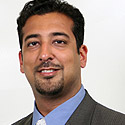|
|
|
Contributors | Messages | Polls | Resources |
|
How BT Learned to Love 4K AUSTIN, Texas -- Big Communications Event -- Becoming a sports broadcaster was a big step for British incumbent BT Group plc (NYSE: BT; London: BTA), and yet that is what the operator has achieved in the past five years. Today it is the home for a number of sporting events, including the European Champion's League and the English Premier League soccer tournaments, the most-watched sports events in the UK. Neil McRae, MD technology and architecture and BT Group chief architect, discussed the operator's evolution into a sports broadcaster and the technical challenges it had to deal with during his keynote at Light Reading's Big Communications Event (BCE) in Austin, Texas, earlier this week. BT's sports journey started when London was selected as the venue for the 2012 Olympic games. As the incumbent telco, BT was involved with connecting the various venues and working with the broadcaster, the British Broadcasting Corp. (BBC) . As part of this exercise, BT built the Olympic Park Studio at Stratford, where the main Olympic stadium was located. A successful Olympics gave BT a taste for sports, and the operator subsequently bid for the rights to the English Premier League, the top soccer league in the UK. Soccer is by far the most popular sport in the country, as in most countries around the world, so the rights were tightly contested and extremely valuable. BT went on to also bid for -- and win rights -- to the European Champion's League, Europe's top soccer tournament in 2014 and 2015. Having opted to distribute this content, the operator decided 4K was the future, and it made sense to produce and distribute these matches in 4K UHD. But at the time, the technology was in its infancy. There were few standards, and everything had to be built from scratch -- starting with the camera lenses. Integration and interoperability was also problematic, as the array of disparate pieces of equipment and technology had never talked to each other before. And video capture and delivery is all about synchronization -- anything out -of-sync immediately affects the viewer experience. (See BT Sport's COO Discusses UHD.) "We needed lots of 'bleeding edge' technology," said McRae, "and we needed to make it talk to each other." BT also needed "huge bandwidth." as well as outdoor broadcast facilities that could support 4K. Fortunately, being a telco was quite useful here, as the operator could connect the various stadiums via fiber and lower its ongoing video contribution costs. McRae listed the various challenges the operator faced on a slide:
Management at the two leagues, the British Football Association (FA) and the Union of European Football Associations (UEFA,) also had to be convinced that their respective games could be delivered reliably and at high quality in 4K by BT. According to McRae, end-to-end testing was key, both for the leagues and for the team itself to identify and resolve issues. McRae took the audience through the various technology integrations and investments that BT used, and it's approach to developing a high-quality end-to-end capture and delivery system for 4K video. But the operator managed to pull it off, and now offers 200 soccer games every season. The success with BT Sports' soccer coverage in 4K has also given the team the confidence to add more sports: BT offered coverage of Moto GP from the famous Silverstone racing track. It also has broadcast an NBA basketball game from London as well as mixed martial arts (MMA) competitions. The operator added Dolby Atmos technology to enhance the audio experience as well and it has found a few ways to create new efficiencies, such as being able to combine UHD and HD streams into a single outdoor broadcast unit which processes both streams. Unlike most broadcasters, BT has the flexibility to use its content to also help drive broadband subscriptions, and the company has used its sports content to drive subscription through various promotions and discounted or free access to BT Sports for BT broadband subscribers. While McRae did not address this, it is probably the most important benefit for BT. The licensing costs for soccer in the UK are extremely high, and recovering the billions spent purely via a premium broadcast channel would be an extremely risky strategy. But the business case becomes a lot stronger when you factor in the positive impact on broadband subscriptions resulting from the coverage. — Aditya Kishore, Practice Leader, Video Transformation, Telco Transformation |
Contentious issues that are likely to fuel lawsuits and angry blogs in the coming year.
Content producers are unhappy with the advertising approach and revenues they are getting on Facebook Watch.
OTT video usage is driving the penetration of various Internet connected devices to help view online streams on the larger TV screen.
Major Hollywood studio to trial 'virtual' movie theaters using head-mounted displays.
Network technology vendor Sandvine has found that piracy isn't only hurting network operator profits – each pirated set-top box is also using up 1TB per month in 'phantom bandwidth.'
 On-the-Air Thursdays Digital Audio On-the-Air Thursdays Digital AudioARCHIVED | December 7, 2017, 12pm EST
Orange has been one of the leading proponents of SDN and NFV. In this Telco Transformation radio show, Orange's John Isch provides some perspective on his company's NFV/SDN journey.
 Special Huawei Video Special Huawei VideoHuawei Network Transformation Seminar The adoption of virtualization technology and cloud architectures by telecom network operators is now well underway but there is still a long way to go before the transition to an era of Network Functions Cloudification (NFC) is complete. |
|
|
|
||


















